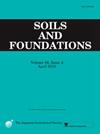Experimental study on improving the effect of microorganisms in solidifying fine-grained soil by red mud
IF 3.3
2区 工程技术
Q2 ENGINEERING, GEOLOGICAL
引用次数: 0
Abstract
To improve the reinforcement effect of MICP technology on fine-grained soil, and consider the fine particle size and activity characteristics of red mud, the experiment of red mud strengthening MICP solidified fine-grained soil was designed and carried out. Combined with mechanical test and microstructural analysis, the enhancing mechanism of red mud on microbial solidified fine-grained soil was comprehensively evaluated. The results show that: (1) Red mud can significantly improve the production of cement during microbial reinforcement of fine-grained soils; the optimal dosage of red mud is 20 %, which increases the strength by 34.6 % and the production of cement by 42.9 %, compared with conventional MICP. (2) After red mud was incorporated into the soil, the pore volume and pore diameter of the treated soil were significantly reduced, and the overall compactness was further improved. (3) The enhancement mechanism of microbial consolidation of fine-grained soils by red mud is mainly due to the presence of chemically active β-C2S and calcium oxide in red mud. These active calcium-based components undergo hydration and carbonation reactions under the action of microbial mineralization, generating calcium carbonate and hydrated calcium silicate, which improves the cement yield and enhances the intergranular bond strength, compactness and overall reinforcement effect of the treated soil.
赤泥提高微生物固化细粒土效果的实验研究
为提高MICP技术对细粒土的加固效果,考虑到赤泥的细粒径和活性特性,设计并开展了赤泥加固MICP固化细粒土的试验。结合力学试验和微观结构分析,综合评价赤泥对微生物固化细粒土的增强机理。结果表明:(1)细粒土微生物加固过程中,赤泥能显著提高水泥产量;赤泥的最佳掺量为20%,与常规MICP相比,强度提高34.6%,水泥产量提高42.9%。(2)土中掺入赤泥后,处理后土的孔隙体积和孔径显著减小,整体密实度进一步提高。(3)赤泥增强细粒土微生物固结的机制主要是由于赤泥中存在化学活性β-C2S和氧化钙。这些活性钙基组分在微生物矿化作用下发生水化和碳酸化反应,生成碳酸钙和水化硅酸钙,提高了水泥成品率,增强了处理后土壤的粒间粘结强度、密实度和整体加固效果。
本文章由计算机程序翻译,如有差异,请以英文原文为准。
求助全文
约1分钟内获得全文
求助全文
来源期刊

Soils and Foundations
工程技术-地球科学综合
CiteScore
6.40
自引率
8.10%
发文量
99
审稿时长
5 months
期刊介绍:
Soils and Foundations is one of the leading journals in the field of soil mechanics and geotechnical engineering. It is the official journal of the Japanese Geotechnical Society (JGS)., The journal publishes a variety of original research paper, technical reports, technical notes, as well as the state-of-the-art reports upon invitation by the Editor, in the fields of soil and rock mechanics, geotechnical engineering, and environmental geotechnics. Since the publication of Volume 1, No.1 issue in June 1960, Soils and Foundations will celebrate the 60th anniversary in the year of 2020.
Soils and Foundations welcomes theoretical as well as practical work associated with the aforementioned field(s). Case studies that describe the original and interdisciplinary work applicable to geotechnical engineering are particularly encouraged. Discussions to each of the published articles are also welcomed in order to provide an avenue in which opinions of peers may be fed back or exchanged. In providing latest expertise on a specific topic, one issue out of six per year on average was allocated to include selected papers from the International Symposia which were held in Japan as well as overseas.
 求助内容:
求助内容: 应助结果提醒方式:
应助结果提醒方式:


